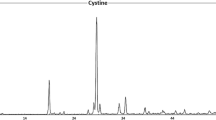Abstract
The precise relationship between urine composition and stone formation has not yet been completely understood. The object of this work is to study some constituents of the urine in stone formers and normal subjects in a trial to correlate stone formation with urine composition. Urinary levels of oxalic acid, uric acid and phosphate were elevated in oxalate, urate and phosphate stone formers, respectively, while in the urine of mixed stone formers both oxalic and uric acids were increased.
Urinary levels of ascorbic acid, citric acid and mucopolysaccharides in all groups of patients were significantly higher than the corresponding control levels. Although oxalic acid, uric acid and phosphate concentrations were high in their respective stones, the concentrations of these constituents were nearly the same in the mixed stones. Also Ca2+ concentration was higher in stones of oxalate and mixed stone formers than in stones of urate and phosphate formers. Exceptionally, magnesium was high in stones of phosphate stone formers.
It is recommended that urinary contents of oxalate, urate and phosphate have to be minimized to overcome stone recurrence.
Similar content being viewed by others
References
Vermeulen, C. W., Lyon, E. S., Fried, F. A.: On the nature of the stone-forming process.J. Urol., 94, 176 (1965).
Boyce, W. H.: Organic matrix of human urinary concretions.Am. J. Med., 45, 673 (1968).
Howard, J. E., Thomas, W. C.: Control of crystallization in urine.Am. J. Med., 45, 693 (1968).
Hockaday, T. D. R., Frederic, E. W., Clayton, J. E., Smith, L. H. C.: Studies on primary hyperoxaluria. II. Urinary oxalate, glycolate and glyoxylate measurement by isotope dilution.J. Lab. Clin. Med., 65, 677 (1965).
Zollner, N., Griebsch, A.: Influence of various dietary purines on uric acid production. Renal Stone Research Symposium, Madrid.
Conte, A., Roca, P., Genestar, C., Grases, F.: Uric acid and its relationship with glycosaminoglycans in normal and stone-former subjects.Nephron, 52/2, 162 (1989).
Edwards, N. A., Russel, R. G. G., Hodgkinson, A.: Effect of oral phosphate in patients with recurrent renal calculus.Br. J. Urol., 37, 390 (1965).
Bernstein, D. S., Newton, R.: The effect of oral sodium phosphate on the formation of renal calculi and on idiopathic hypercalciuria.Lancet, 2, 1105 (1966).
Hallson, P. C., Rose, G. A., Sulaiman, S.: Raising urinary citrate lowers calcium oxalate and calcium phosphate crystal formation in whole urine.Urol. Int., 38/3, 179 (1983).
Smith, L. H.: Risk of oxalate stones from large doses of vitamin C.N. Engl. J. Med., 298, 856 (1978).
Bonsens, R. W., Taussky, H. H.: Determination of creatinine.J. Biol. Chem., 158, 581 (1945).
Hodgkinson, A.: A combined quantitative and qualitative procedure for the chemical analysis of urinary calculi.J. Clin. Pathol. 24, 147 (1971).
Caraway, W. T.: Chemical and diagnostic specificity of laboratory tests: Effect of hemolysis, lipemia, anticoagulants, medications, contaminants and other variables.Am. J. Clin. Pathol. 37, 445 (1962).
Fiske, C. H., Subbaraw, Y. J.: The colorimetric determination of phosphorus.J. Biol. Chem., 66, 375 (1925).
Snell, F. D., Snell, C. T.: Colorimetric Methods of Analysis, 3rd ed. Van Nostrand, New York 1949.
Roe, J. H., Kuether, C.: A: Determination of ascorbic acid in whole blood and urine.J. Biol. Chem., 147, 399 (1943).
Vitiello, F., Carlomagno, M., Di Benedetta, C.: Urinary acid mucopolysaccharide determination: A modification of the method.Biochem. Med., 17, 187 (1977).
Kitomura, K., Lijma, N., Hasimoto, F., Hiratsuke, A.: Hereditary deficiency of subunit H of lactate dehydrogenase.Clin. Chim. Acta, 34/4, 19 (1971).
Murthy, M. S. R., Talwar, H. S., Thind, S. K., Nath, R.: Vitamin B6 deficiency as related to oxalate synthesizing enzyme in growing rats.Ann. Nutr. Metab., 26/3, 201 (1982).
Elliot, J. S.: Calcium stones: The difference between oxalate and phosphate types.J. Urol. (Baltimore),100, 687, (1968).
Strauss, A. L., Coe, F. L., Parks, J. H.: Formation of a single calcium stone of renal origin: Clinical and laboratory characteristics of patients.Arch. Intern. Med., 142/3, 504 (1982).
Fellstrom, G., Ljunghall, S., Wikstrom, B.: Urinary excretion of urate in renal calcium stone disease and in renal tubular acidification disturbances.J. Urol., 127, 589 (1982).
Hodgkinson, A.: Uric acid disorders in patients with calcium stones.Br. J. Urol., 48, 1 (1976).
Fellstrom, B., Backman, U., Danielson, B. G., Johansson, G., Ljunghall, S., Wikstrom, B.: Uricemia and urinary acidification in renal calcium stone disease.J. Urol., 129, 256 (1983).
Greaf, V., Schmidtmann, H., Jarrar, K. Urinary isocitrate excretion in normal individual and in stone patients. In: Schwill, P. O., Smith, L. H., Robertson, W. G., Vahlensieck, W. (eds): Urolithiasis and Related Clinical Research. Plenum Press, New York-London 1985, p. 363.
Danielson, B. G.: Renal stone—current view point on etiology and management.Scand. J. Urol. Nephrol., 19/1, 1 (1985).
Butz, M.: Oxalate stone prophylaxis by alkalinizing therapy.Urol. AUSG A, 21/3, 142 (1982).
Hwang, T. I. S., Preminger, G. M., Pointexter, J., Pak, C. Y. C.: Urinary glycosaminoglycans in normal subjects and patients with stones.J. Urol., 139/5, 995 (1988).
Sidhu, H., Hemal, A. K., Thind, S. K., Nath, R., Vaidyanathan, S.: Comparative study of 24 hours urinary excretion of glucosaminoglycans by renal stone formers and healthy adults.Eur. Urol. 16/1, 45 (1989).
Gambaro, G., Cicerello, E., Mastrosimone, S., Del Prete, D., Di Lenardo, L., Baggio, B.: Increased urinary excretion of glycosaminoglycans in pregnancy and in diabetes mellitus: A protective factor against nephrolithiasis (Letter).Nephron, 50/1, 62 (1988).
Fellstrom, B., Danielson, B. G., Ljunghall, S., Wikstrom, B.: In: Schwille, P. O., Smith, L. H., Robertson, W. G., Vahlensieck, W. (eds): Urolithiasis and Related Clinical Research. Plenum, New York 1985.
Author information
Authors and Affiliations
Rights and permissions
About this article
Cite this article
Abdel-Aziz, A.F., El-Waseef, A. & El-Fotouh, M.A. Biochemical relationship between urine composition and urinary stone formation in stone forming patients. International Urology and Nephrology 28, 457–464 (1996). https://doi.org/10.1007/BF02550950
Accepted:
Issue Date:
DOI: https://doi.org/10.1007/BF02550950




